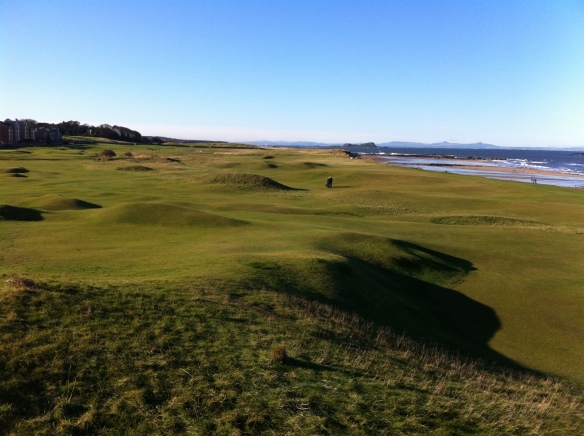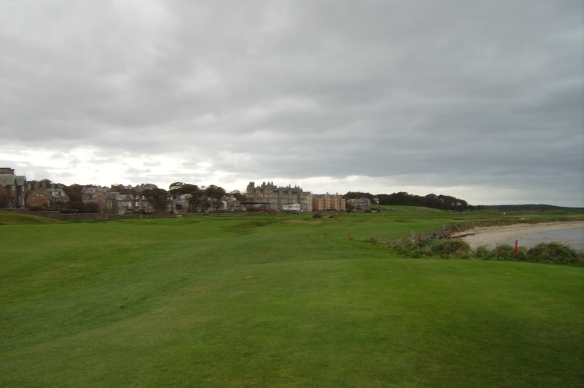“No golf course could look lovelier that North Berwick on a bright summer’s day, when the Bass rock, the home of many gannets, is shining brilliantly white in the sunshine …”
My visit to North Berwick was not punctuated by sunshine, but by rain clouds. I saw the course in October, not a bright summer’s day. My pilgrimage to the Home of Golf was planned as a celebration of my brother-in-law’s 40th birthday. It included stops at the aforementioned as well as the Old Course, Kingsbarns, Carnoustie, Castle and Renaissance. Despite the rain and cold and wind, North Berwick emerged as my favorite.
Darwin writes:
“Personally, I have a considerable respect for North Berwick, born of fear and conscious incompetence. I always have that respectful feeling towards a course where the ground is a little hard and bumpy.”
Conscious incompetence is exactly how our foursome played for a week in Scotland. We hit drivers when the wind was dead into our faces. I hit 8 iron to the first hole at the Old Course when my caddie pulled a 6. (My ball found a watery grave in the Swilcan Burn.) And my brother-in-law sought to keep the rain from his face with some kind of Urban Sombrero recommended in a Sports Illustrated article. North Berwick was a fine introduction to Scottish golf. The wind took his wide-brimmed hat and practically choked him with the elastic drawcord (bringing him close to unconscious incompetence.)
Darwin continues his account of North Berwick by regaling us with stories of Point Garry and the Prime Minister, Carl Kemp, the famous Crawford and of course Perfection and The Redan. But it is with great interest that I note a tongue-in-cheek comment by Mr. Darwin about a location early in the round:
“The second and third are both fine holes, and at the second we have an added interest in the possibility of killing some one upon the sea-shore. With a fine long shot we may hope to carry a portion of the beach that eats its way into the course, but it is not well to be too adverturous; anything approaching a slice will leave us playing niblick shots among the pebbles and nurserymaids …”
Now, I don’t mean to make light of the “possibility of killing some one”, either on the golf course or anywhere else, but I am interested in all the different bad things that can happen on a golf course. Good to know that errant shots to neighboring property was on Mr. Darwin’s radar back in 1910. Thankfully, Christopher Spencer, Secretary of the North Berwick Golf Club, reports no injuries in his 5 years at the helm.
Here are two views of the 2nd hole, courtesy of Mr. Spencer:
With the course (and beach!) deserted on our rainy Sunday afternoon, I paused to snap a couple photographs of my own to “document” this unique golf course risk. I don’t get enough chances to play on golf courses where beachland borders salt water.
My Spin: I have not researched the specifics of Scottish law on liability for errant golf shots. Mr. Spencer referenced the Right to Roam legislation in Scotland that allows the public to walk where they like – provided they respect the original use of the land and those using it.
In the United States, with our independent state courts, there is no hard and fast rule to apply to injuries to people beyond the boundaries of the golf course. I have read many such cases. The ruling can depend on any number of factors – public land or private land, number of errant golf shots over time, which was there first – golf course or adjacent property, was the injured party the property owner or a visitor, steps taken by the golf course to reduce the risk etc. Although the outcome in each case may be somewhat in doubt, I do think it is advisable for the golf course to address the problem. The risk of serious injury to a neighbor or passer-by can be substantial. The potential multi-million dollar personal injury recovery and impact of a lawsuit on business operations are evidence enough for me.
It would be an interesting study to see how golf courses here in the litigious United States handle situations where land (golf course) meets sea. I am sure there are plenty of high profile examples. I can not claim any first-hand knowledge of Pebble Beach Golf Links. It is on my bucket list. I doubt any of my errant shots could have reached beachcombers at the Ocean Course at Kiawah. The beach is a long way down and quite deserted near Bandon Dunes. The same with Whistling Straits. I wonder what these and other similarly situated golf courses do about the risk of injury from an errant shot.
I know where I would start. The same place as North Berwick – with well defined golf course boundaries and stakes. Whether playing stroke or match play, one thing is for certain, golfers don’t like penalties. Keeping the specter of hazards and out-of-bounds at the forefront of their mind is subtle encouragement to aim away from danger. Savvy golf course architects do the same with their design features – framing the hole to encourage safety and discourage shots toward adjacent property.
Rarely does one solution solve all of your problems. A golf course can implement a series of liability management techniques, ranging from simple to complex … and don’t forget to consider the easiest (and cheapest) of alternatives. Take a page out of North Berwick’s book and make sure your golf course boundaries are well marked and staked. It may make a difference to the health and welfare of beach-goers and nurserymaids.




